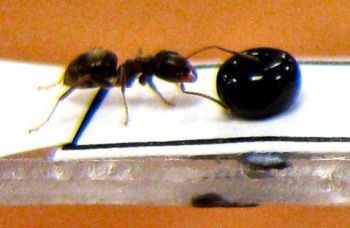Broadcast: News items
How ants handle the rush hour
Posted on behalf of: Laboratory of Apiculture and Social Insects
Last updated: Wednesday, 30 January 2013

A common garden ant (Lasius niger) checking a black bead laced with ant pheremone - as the ant encounters more "nest-mates" it lays down less pheremone on the trail
Scientists at the University of Sussex have discovered how ants respond to heavy traffic to and from the nest.
Ants, like humans, form complex transport networks – and, like humans, they can end up in traffic jams that cause unwelcome hold-ups.
However, unlike humans, ants do not have managers to oversee traffic organisation.
This means that ants have to ‘self-organise’ – managing the flow of ants to and from a food source without any one ant knowing what the traffic is like across the entire network.
The researchers investigated how ants deploy scent trails in a laboratory experiment using the common garden ant Lasius niger – and uncovered a way in which ants might achieve time-saving traffic control.
The ants were introduced to a food source at the end of a path. When ants find a food source they return to the nest, laying a chemical trail for their nest-mates to pick up and follow. This means that they can work together to transport food back to the nest quickly and efficiently.
However, the researchers found that, when the trail was crowded with ants, each individual ant laid a lot less of the chemical – less than a fifth of what they would normally lay.
The scientists then placed lone ants on the path, but put ‘fake’ ants – glass beads that smelled like ants – along the route.
After contact with 10 fake ants, the lone ants reduced the amount of chemical they laid by almost 50 per cent – the ant responded to the high volume of ‘traffic’ on the route by laying down less and less scent.
Researchers think that this behaviour allows ant colonies to “reroute” traffic via less busy parts of the trail network: if the ants lay less chemical on busy paths, fewer ants will follow, switching instead to alternative, less congested routes with stronger scent trails.
Dr Tomer Czaczkes, who led the research, says: “Using simple rules, ant colonies can do the right thing even if no individual ant knows everything that is happening in the colony.
“The ants’ behaviour is an example of ‘swarm intelligence’ – a mechanism that could become important for humans in the future when, as in the case of ants, our networks get too complicated for any one manager to know what is actually going on.”
Professor Francis Ratnieks was also involved in the research and is head of the Laboratory of Apiculture and Social Insects at the University of Sussex, where the research was carried out.
He says: “Ants and bees use many neat tricks to coordinate and organise the many workers in a colony so that they function together effectively in foraging and other tasks. This is another example. When a trail to food gets crowded, less pheromone is laid. This will tend to reduce the crowding.”
‘Negative feedback in ants: Crowding results in less trail pheromone deposition’ by T. Czaczkes, C. Grüter and F. Ratnieks was published in the Royal Society journal Interface today (Wednesday 30 January).

